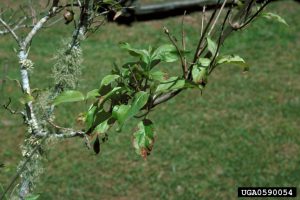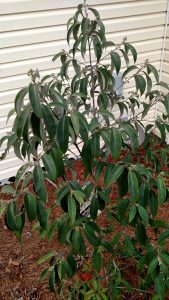Everyone, or at least everyone fortunate enough to grow up in the South, has a fond memory tucked away of a sight or smell of a plant that reminds them of the good old days. Maybe it’s the ancient camellia at your grandmother’s house that just feels like home when you see it. Maybe it’s a persimmon tree with fruit weighing on the branches, the smell of baked persimmon bread cooling in the kitchen close behind. For me and countless others, it’s the sight of the iconic native flowering dogwood (Cornus florida) blooming each spring in the understory of Panhandle forests. However, if you’ve been paying attention, the spring dogwood bloom has diminished with each passing year, leaving many folks wondering what happened. As with many things, the answer is multi-faceted and complicated.
First, as homeowners who have grown dogwoods for many years are well aware, dogwoods are notoriously susceptible to harsh site conditions. In the landscape setting, much of the difficulty in growing dogwoods may be attributed to Florida’s frequent extended droughty periods and improperly citing the trees in a full-sun location. dogwoods naturally prefer a cool, moist root zone and protection from the hot afternoon sun; failure to provide such a setting will most likely lead to scorched-appearing foliage, overall poor performance and a short-lived tree.
More problematic are the many diseases dogwoods are prone to, including several fungal leaf spots, cankers and mildew diseases, all of which impair their ability to create energy and store the needed nutrients to survive tough periods (frequent droughts). All of these diseases are much more problematic in the unseasonably warm, wet winters and cool, wet springs Floridians have been experiencing with regularity over the last decade. It is good practice to actively clean up any fallen, diseased leaves as well as to prune out any obviously dead or diseased wood to prevent problems from spreading further, but total suppression of these diseases is impractical for most homeowners.
As if all of those problems weren’t enough, the most sobering issue currently facing flowering dogwood is a fungal disease known as dogwood anthracnose (Discula destructiva). D. destructiva has been confirmed responsible for the decline of dogwoods in more upland areas around the foothills of the Appalachians and has been surmised to have moved south into the coastal plain, although its presence in our area has largely been undocumented. As with other pathogens, disease incidence is increased in already stressed trees as well as in mild, wet-weather conditions in the spring and fall. Symptoms of D. destructiva usually begin with purplish spots on the margins of leaves in early summer, with infected leaves hanging onto the tree through winter. The disease then spreads down through the tree and manifests itself as a sort of dieback of twigs and limbs, eventually forming cankers and killing the tree.
As dire as the dogwood situation may seem, there are some potential solutions. First, if you must plant a flowering dogwood, make sure you give it an ideal situation. Irrigate when rainfall is inconsistent, apply a layer of an organic mulch (pinestraw, wood chips, etc.) at a depth of 2”-3”, and plant in a protected, shady situation. If growing a native dogwood might seem too challenging, there is a related species from Asia called kousa dogwood (Cornus kousa) that deserves to be planted more. Kousa dogwood is not a perfect tree but it retains most everything we love about native dogwoods without the disease issues!
Kousa’s retain the classic creamy white flowers, attractive berries in fall, and layered branching (called sympodial branching) of our native dogwoods but also bring a few extra attributes to the table. Kousa dogwood grows to a rounded 15’-20 in height and width, is much more tolerant of cultural extremes than flowering dogwood and is resistant to the various diseases that plague native dogwoods. Also, there is a subspecies of kousa dogwood, Cornus kousa var. angustata that is even evergreen in our area, no more barren limbs in the winter! The most popular selection of this subspecies is a beautiful little tree being marketed as ‘Empress of China’ through the southern living plant collection; I am currently trialing this tree in my yard and it has impressed so far.
So to wrap up, if the decline of the dogwoods has you down, there are three things you can do:
- Give your existing dogwoods some TLC, keep them well-watered in droughty periods and mulch to keep the roots cool.
- Cut out any dead or diseased branches in existing dogwoods and rake and dispose of leaves from previous years that are lying around.
- If you want to plant a new dogwood, try a kousa dogwood (Cornus kousa) as this species is a more than adequate replacement for Cornus florida!
As always, consult your local UF/IFAS Extension Office with any questions or concerns you have regarding your landscape and happy gardening!
- Easy Spring Color with Petunias - April 5, 2024
- Blue Blooming Beauties of the Florida Panhandle - October 26, 2023
- When It’s Too Hot to Garden. What to Do? - August 24, 2023


